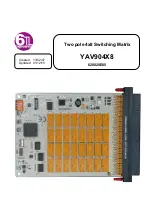
Kramer Electronics Ltd.
AFM-20DSP
– Connecting the 20-Port Audio Matrix
13
▪
HDMI OUT
to an acceptor (for example, a display).
4. Connect the S/PDIF digital audio ports as follows:
▪
A source (for example, a Blu-ray player to S/PDIF IN
.
▪
S/PDIF OUT
to an acceptor (for example, an audio receiver).
5. Connect the USB
to a computer such as a laptop
▪
To process the USB audio as a stereo speaker.
▪
To operate as an audio line-in or microphone for an audio recorder application or call
conferencing.
6. Connect the SPEAKER OUT Hi-Z OUT or Lo-Z OUT 4-pin terminal block connector
as follows:
▪
For Hi-Z connection: connect Hi-Z and COM terminal blocks to the + and
– terminals
of a mono speaker (for example, the
Galil 8-C
ceiling speakers, daisy chained).
The speakers either output the left side (L+, L-) of the audio input or the stereo input
reduced to a mono signal (see
) .
▪
For Lo-Z connection: connect the L+ and L- connectors to the left-side speaker (for
example,
Yarden 6-O
) and the R+ and R- connectors to the right-side.
7. Connect the Dante RJ-45 port
to up to 4Tx and for Rx audio channels via the
network.
8. Connect the RS-232 3-pin terminal block connector
to the RS-232 port on a
controller (for example, a laptop) to control the
AFM-20DSP
.
9. Connect the ETHERNET RJ-45 port
to the Ethernet to control the
AFM-20DSP
and
use for firmware upgrade.
10. Connect the mini USB connector
to a control device (for example, a laptop) to
control the
AFM-20DSP
.
11. Connect the power cord to the
AFM-20DSP
mains socket
and to the mains
electricity (not shown in
10
12
10
8
13
14
15
16
17
19
















































